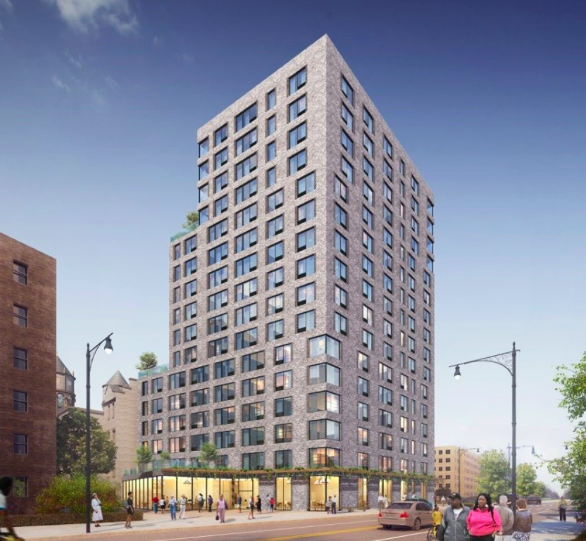
NYCHA/BFC
Rendering of a new senior housing facility at Ingersoll Houses.
As of May 28, there were 58,007 people in New York City homeless shelters, including 20,740 children. The number of families in the system in April was the lowest it had been that month since 2015, but the number of single adults in shelters has climbed 35 percent over the same period.
In other housing news this week:
• Residents from the Fulton Houses NYCHA development marched on City Hall on Wednesday protesting the City’s plans for private developers to build new apartments at the complex, transfer current NYCHA residents and eventually demolish existing the Fulton Houses. The demolition would be part of NYCHA’s Rental Assistance Demonstration (RAD) conversion program. The city recently spent $700,000 on a new playground that would be demolished under the new plan.
#FultonHouses Tenants Marching towards City Hall to protest against the demolition on conversion of their #nycha complex. @FightForNYCHA @errollouis @infopobn @luisferre @thevillagernyc @CCNewsNYC @Gothamist @monicamoralestv #KeepPublicHousingPublic pic.twitter.com/T6bpxXzC1O
— Marni Halasa (@Marni4Council) May 29, 2019
• The Senior Citizen Rent Increase Exemption and Disabled Rent Increase Exemption could be a lot to shield vulnerable New Yorkers from rising rents. Both programs cap rents at 30 percent of income or the lease rent at the time of enrollment, whichever is higher. But both SCRIE and DRIE are perpetually under-enrolled, most likely because many seniors and people with disabilities do not know about them. To combat that, State Senator Liz Krueger and Assemblymember Linda Rosenthal, with the backing of Comptroller Scott Stringer, have introduced state legislation that would require formal notice of the program to be provided to eligible people “at the same time as they receive routine communications from landlords or government agencies regarding such issues as an application for a rent adjustment due to a major capital improvement, a rent increase, or notice of a new lease or renewal of a lease,” according to Stringer’s office.
• The Department of Homeless Services released the results of its annual Homeless Outreach Population Estimate (HOPE) street homeless survey, based on a one-night count in January, and it found that the number of people unsheltered on city streets was 3,588, a 2 percent drop from last year. Advocates have long questioned the utility of the federally mandated HOPE survey because of its limited timeframe and reach. Defenders of the count say that while it is likely not comprehensive, it does provide something of a consistent indicator of visible street homelessness year to year.
Get the best of City Limits news in your inbox.
Select any of our free weekly newsletters and stay informed on the latest policy-focused, independent news.
• Most public elementary schools have one ethnic or racial group that has a significantly larger presence compared to other racial or ethnic groups, according to a new report that examines the linkages between school and housing segregation. The report also found that students from Black, Latino and lower-income backgrounds remain isolated when compared with their Asian or white peers from higher-income backgrounds.
• A portrait of an eviction in Queens: The Queens Eagle spoke with Long Island City tenants facing eviction proceedings after the single-room apartment building was sold to a new landlord. The sale depends on the potential to evict.
• Public Advocate Jumaane Williams introduced a bill Wednesday that would require the city to study how rezonings impact the racial makeup of neighborhoods. Read more from City Limits on the push for racial impact studies here.
• With the prospect of stronger rent regulations on the near horizon, some on of New York City’s most powerful real estate companies, including the Blackstone Group, A&E Real Estate Holdings and Taconic Investment Partners met with affordable housing advocates in an effort to negotiate a compromise, Gothamist reports. It’s not clear that the meeting led to anything.The effort to compromise is part of a broad strategy of resistance that includes a digital ad blitz.
• Applications have opened for a 100-unit senior-only Section 8 building on NYCHA’s Ingersoll campus. Go here to enter your info.








